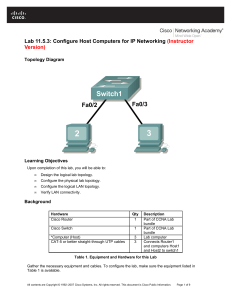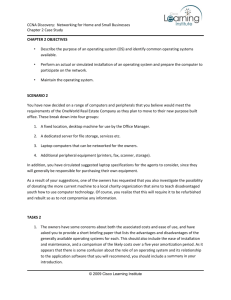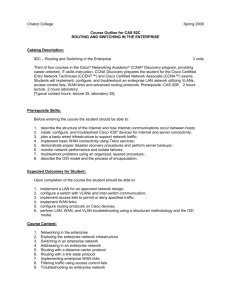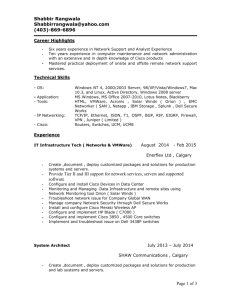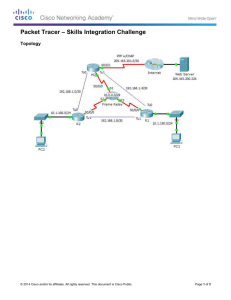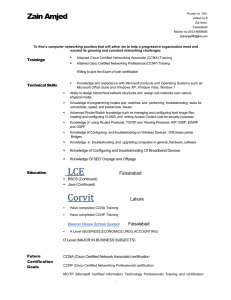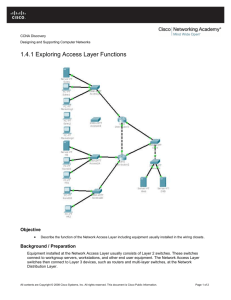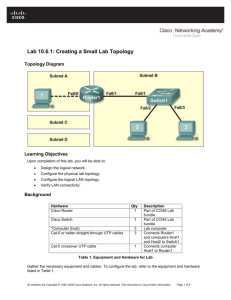E1_Lab_11_5_3_in
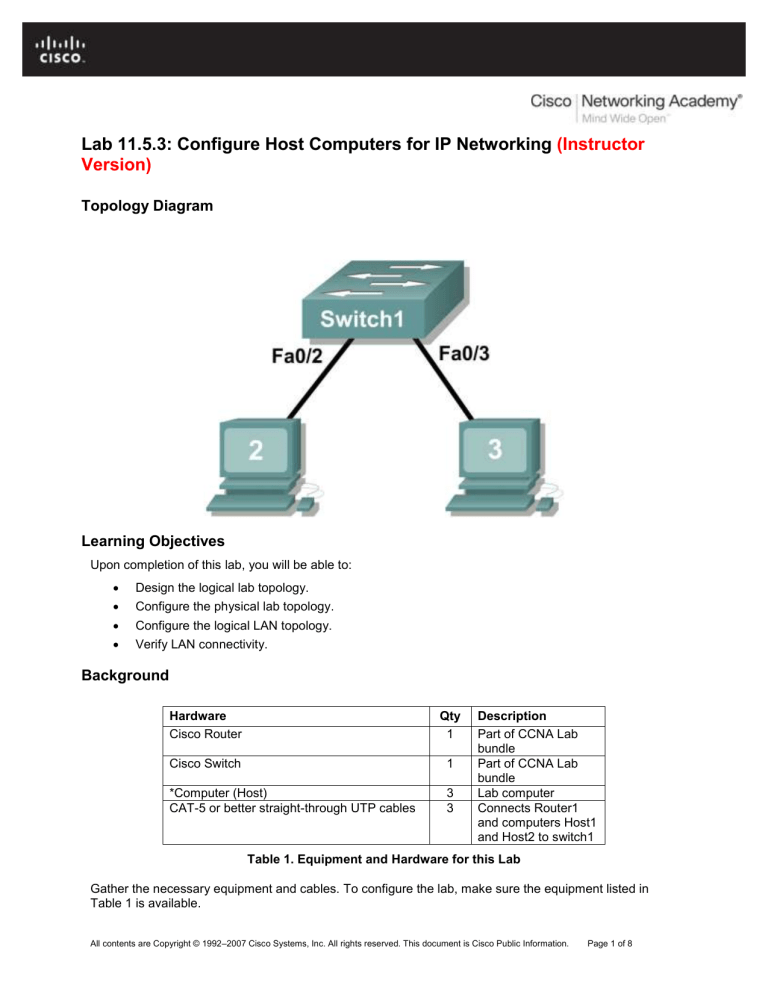
Lab 11.5.3: Configure Host Computers for IP Networking (Instructor
Version)
Topology Diagram
Learning Objectives
Upon completion of this lab, you will be able to:
Design the logical lab topology.
Configure the physical lab topology.
Configure the logical LAN topology.
Verify LAN connectivity.
Background
Hardware
Cisco Router
Cisco Switch
*Computer (Host)
CAT-5 or better straight-through UTP cables
Qty Description
1 Part of CCNA Lab bundle
1 Part of CCNA Lab bundle
3 Lab computer
3 Connects Router1 and computers Host1 and Host2 to switch1
Table 1. Equipment and Hardware for this Lab
Gather the necessary equipment and cables. To configure the lab, make sure the equipment listed in
Table 1 is available.
All contents are Copyright © 1992–2007 Cisco Systems, Inc. All rights reserved. This document is Cisco Public Information. Page 1 of 8
CCNA Exploration
Network Fundamentals:
Configuring and Testing Your Network
Scenario
Lab 11.5.3 Configure Host Computers for IP Networking
In this lab students will create a small network that requires connecting network devices and configuring host computers for basic network connectivity. The Appendix is a reference for configuring the logical network.
Note to instructor: To reinforce student cable identification, have several different types of cables available for the students. Mix cross-over, straight-through, and rollover cables. Students should be able to identify the proper cable type based on a visual inspection.
Task 1: Design the Logical Lab Topology.
1. Given an IP address of 192.168.254.0/24 , and 5 bits used for subnets, fill in the following information:
Maximum number of usable subnets (including the 0 th subnet): _____ 31 _____
Number of usable Hosts per subnet: _____ 6 _____
IP Address: 192.168.254.0 Subnet mask: 255.255.255.248
# Subnet First Host address Last Host address Broadcast
4
5
6
7
0
1
2
3
192.168.254.0
192.168.254.8
192.168.254.16
192.168.254.24
192.168.254.32
192.168.254.40
192.168.254.48
192.168.254.56
192.168.254.1
192.168.254.9
192.168.254.17
192.168.254.25
192.168.254.33
192.168.254.41
192.168.254.49
192.168.254.57
8
9
192.168.254.64
192.168.254.72
10 192.168.254.80
11 192.168.254.88
192.168.254.65
192.168.254.73
192.168.254.81
192.168.254.89
12 192.168.254.96 192.168.254.97
13 192.168.254.104 192.168.254.105
14 192.168.254.112 192.168.254.113
15 192.168.254.120 192.168.254.121
192.168.254.6
192.168.254.14
192.168.254.22
192.168.254.30
192.168.254.38
192.168.254.46
192.168.254.54
192.168.254.62
192.168.254.70
192.168.254.78
192.168.254.86
192.168.254.94
192.168.254.102
192.168.254.110
192.168.254.118
192.168.254.126
192.168.254.7
192.168.254.15
192.168.254.23
192.168.254.31
192.168.254.39
192.168.254.47
192.168.254.55
192.168.254.63
192.168.254.71
192.168.254.79
192.168.254.87
192.168.254.95
192.168.254.103
192.168.254.111
192.168.254.119
192.168.254.127
16 192.168.254.128
192.168.254.129
17 192.168.254.136
192.168.254.137
18 192.168.254.144
192.168.254.145
19 192.168.254.152
192.168.254.153
20 192.168.254.160
192.168.254.161
21 192.168.254.168
192.168.254.169
22 192.168.254.176
192.168.254.177
23 192.168.254.184
192.168.254.185
192.168.254.134
192.168.254.142
192.168.254.150
192.168.254.158
192.168.254.166
192.168.254.174
192.168.254.182
192.168.254.190
192.168.254.135
192.168.254.143
192.168.254.151
192.168.254.159
192.168.254.167
192.168.254.175
192.168.254.183
192.168.254.191
24 192.168.254.192
192.168.254.193
25 192.168.254.200
192.168.254.201
26 192.168.254.208
192.168.254.209
27 192.168.254.216
192.168.254.217
192.168.254.198
192.168.254.206
192.168.254.214
192.168.254.222
192.168.254.199
192.168.254.207
192.168.254.215
192.168.254.223
28 192.168.254.224
192.168.254.225
29 192.168.254.232
192.168.254.233
30 192.168.254.240
192.168.254.241
192.168.254.230
192.168.254.238
192.168.254.246
192.168.254.231
192.168.254.239
192.168.254.247
2. Before proceeding, verify your addresses with the instructor. The instructor will assign one subnetwork per student or team.
All contents are Copyright © 1992–2007 Cisco Systems, Inc. All rights reserved. This document is Cisco Public Information. Page 2 of 8
CCNA Exploration
Network Fundamentals:
Configuring and Testing Your Network
Task 2: Configure the Physical Lab Topology.
Lab 11.5.3 Configure Host Computers for IP Networking
Step 1: Physically connect devices.
1. Cable the network devices as shown in Figure 1.
Figure 1. Cabling the Network
Is a crossover cable needed to connect Host computers to the switch? Why or why not?
_____________________________________________________________________________
_____________________________________________________________________________
Answer: No. Since computers and the switch are not wired the same for networking, straightthrough cables are used.
If not already enabled, turn power on to all devices.
Step 2: Visually inspect network connections.
After cabling the network devices, take a moment to verify the connections. Attention to detail now will minimize the time required to troubleshoot network connectivity issues later.
Task 3: Configure the Logical Topology.
Step 1: Document logical network settings.
1. Host computers will use the first two IP addresses in the subnetwork. Write down the IP address information for each device:
Device
Host1
Host2
Subnetwork IP address Mask
Answers will vary Answers will vary 255.255.255.248
Answers will vary Answers will vary 255.255.255.248
Figure 2. Logical Topology
All contents are Copyright © 1992–2007 Cisco Systems, Inc. All rights reserved. This document is Cisco Public Information. Page 3 of 8
CCNA Exploration
Network Fundamentals:
Configuring and Testing Your Network Lab 11.5.3 Configure Host Computers for IP Networking
2. From the information given in Figure 2, write down the IP network addressing for each computer:
IP Address
IP Mask
Host 1
Answers will vary
Answers will vary
IP Address
IP Mask
Host 2
Answers will vary
Answers will vary
Step 2: Configure Host1 computer.
1. On Computer1, click Start > Control Panel > Network Connections . Right-click the LAN icon, and choose Properties . On the General tab, select Internet Protocol (TCP/IP) , and then click the Properties button.
Figure 3. Host1 IP Address and Gateway Settings
2. Refer to Figure 3 for Host1 IP address and gateway settings.
3. When finished, click OK , then click Close . The computer may require a reboot for changes to be effective.
4. Verify proper configuration of Host1 with the ipconfig /all command.
All contents are Copyright © 1992–2007 Cisco Systems, Inc. All rights reserved. This document is Cisco Public Information. Page 4 of 8
CCNA Exploration
Network Fundamentals:
Configuring and Testing Your Network
5. Record the output below:
Lab 11.5.3 Configure Host Computers for IP Networking
Setting Value
Ethernet device Answers will vary.
Physical Address Answers will vary.
IP Address Answers will vary.
Subnet Mask Answers will vary.
Default Gateway Not assigned.
Step 3: Configure Host2.
1. Repeat Step 2 for Host2, using IP address information from the table filled out in Step 1.
2. Verify proper configuration of Host1 with the ipconfig /all command.
3. Record the output below:
Setting Value
Ethernet device Answers will vary.
Physical Address Answers will vary.
IP Address
Subnet Mask
Answers will vary.
Answers will vary.
Default Gateway Not assigned.
Task 4: Verify Network Connectivity.
Network connectivity can be verified with the Windows ping command.
1. Use the following table to methodically verify connectivity with each network device:
From
Host1
To
Host2
IP Address
Answers will vary.
Ping results
Answers will vary.
Host2 Host1 Answers will vary.
2. Take corrective action to establish connectivity if a test fails.
Answers will vary.
Note: If pings to host computers fail, temporarily disable the computer firewall and retest. To disable a Windows firewall, click Start > Control Panel > Windows Firewall , choose Off , and then click OK .
Task 5: Reflection
Review any physical or logical configuration problems encountered during this lab. Make sure you have a thorough understanding of the procedures used to configure a Windows host computer.
Task 6: Challenge
Ask your in structor or another student to introduce one or two problems in your network when you aren’t looking or are out of the lab room. Problems can be either physical (wrong UTP cable) or logical (wrong
IP address). To fix the problems:
1. Perform a good visual inspection. Look for green link lights on Switch1.
All contents are Copyright © 1992–2007 Cisco Systems, Inc. All rights reserved. This document is Cisco Public Information. Page 5 of 8
CCNA Exploration
Network Fundamentals:
Configuring and Testing Your Network Lab 11.5.3 Configure Host Computers for IP Networking
2. Use the table provided in Task 3, above, to identify failed connectivity. List the problems:
___________________________________________________________________________
___________________________________________________________________________
___________________________________________________________________________
___________________________________________________________________________
___________________________________________________________________________
3. Write down your proposed solution(s):
___________________________________________________________________________
___________________________________________________________________________
___________________________________________________________________________
___________________________________________________________________________
___________________________________________________________________________
4. Test your solution. If the solution fixed the problem, document the solution. If the solution did not fix the problem, continue troubleshooting.
___________________________________________________________________________
___________________________________________________________________________
___________________________________________________________________________
___________________________________________________________________________
___________________________________________________________________________
Task 7: Clean Up
Unless directed otherwise by the instructor, restore host computer network connectivity, and then turn off power to the host computers. Remove anything that was brought into the lab, and leave the room ready for the next class.
All contents are Copyright © 1992–2007 Cisco Systems, Inc. All rights reserved. This document is Cisco Public Information. Page 6 of 8
CCNA Exploration
Network Fundamentals:
Configuring and Testing Your Network Lab 11.5.3 Configure Host Computers for IP Networking
Appendix
All contents are Copyright © 1992–2007 Cisco Systems, Inc. All rights reserved. This document is Cisco Public Information. Page 7 of 8
CCNA Exploration
Network Fundamentals:
Configuring and Testing Your Network Lab 11.5.3 Configure Host Computers for IP Networking
All contents are Copyright © 1992–2007 Cisco Systems, Inc. All rights reserved. This document is Cisco Public Information. Page 8 of 8
